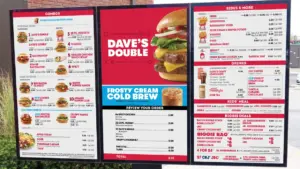The uproar Wendy’s faced regarding its alleged intention to introduce surge pricing at hundreds of its fast-food restaurants could have spelled doom for dynamic pricing startups like Juicer.
However, rather than causing setbacks, the controversy surrounding Wendy’s publicity debacle has prompted industry brands – once previously apprehensive about dynamic pricing – to become more informed about the menu optimization strategy.
And San Francisco-based Juicer is benefiting from a rise in interest.
“It was the best thing that ever happened to us,” Ashwin Kamlani, Juicer co-founder and CEO, told Food on Demand in a recent interview. “There’s a lot of curiosity about this now because of Wendy’s.”
Wendy’s said that some media outlets “misconstrued” the CEO’s remarks
If you’ve been living under a rock lately, here’s a quick recap.
Wendy’s faced a storm of controversy in mid-February when CEO Kirk Tanner announced a $20 million investment in digital menu boards by 2025, intended to test strategies like dynamic pricing.
Within days, his earnings remarks went viral. Wendy’s was being billed as the Uber of restaurants with its plans for surge pricing, the practice of raising prices during peak demand. Widespread anger erupted as critics lambasted Wendy’s for price gouging consumers amid rising fast-food prices.
 In response, Wendy’s said its intention was never to hike in-restaurant prices for customers during peak hours. Issuing a statement 12 days after the earnings call, the chain explained that Tanner’s comments had been “misconstrued,” with some media outlets mistakenly interpreting dynamic pricing as surge pricing.
In response, Wendy’s said its intention was never to hike in-restaurant prices for customers during peak hours. Issuing a statement 12 days after the earnings call, the chain explained that Tanner’s comments had been “misconstrued,” with some media outlets mistakenly interpreting dynamic pricing as surge pricing.
Wendy’s said the company would not “raise prices when our customers are visiting us most.”
“Digital menu boards could allow us to change the menu offerings at different times of day and offer discounts and value offers to our customers more easily, particularly in the slower times of day,” the company said in the statement. “Wendy’s has always been about providing high-quality food at a great value, and customers can continue to expect that from our brand.”
Wendy’s declined to comment further on the chain’s dynamic pricing strategy when asked by Food on Demand.
Dynamic pricing is not the same as price flexibility
Dynamic pricing is a familiar concept in the hospitality industry. Airlines and hotels have long implemented this practice, charging customers higher rates during peak travel periods and reducing prices when demand is lower.
However, dynamic pricing is a relatively new strategy in the restaurant industry. Only a few brands have embraced it by experimenting with dynamic pricing startups like Sauce and Juicer since 2022.
To date, most of the experimentation has focused on optimizing delivery revenue.
Ohio-based Piada Italian Street Food was able to “double delivery margins” using Sauce’s dynamic pricing platform, according to Sauce’s website. Sauce declined to be interviewed for this story.
While restaurants have been raising prices on delivery menus for years to offset high delivery fees, Kamlani notes that that strategy is not the same as dynamic pricing.

Ashwin Kamlani, Juicer co-founder and CEO
“That’s price flexibility. There’s no intelligence behind it,” he said.
Startups like Juicer adjust pricing on delivery items based on AI-driven analysis of consumer buying trends.
“What we do is we analyze every single transaction, every item that was sold for years,” he said.
After analyzing historical buying trends during different dayparts, Juicer’s software might recommend four menu items increase or decrease by 3 percent on a delivery app like DoorDash or Uber Eats, Kamlani said.
“The data is telling us that there’s an opportunity to make more money or that you [the operator] should be running a promotion during a certain period, on certain items, in a certain channel at certain times,” he said.
Brands are now curious about dynamic pricing
But, getting tech-leery restaurants to listen to the benefits of dynamic pricing has been a slow process.
“We were out there beating the drum on dynamic pricing for a couple of years,” said Kamlani, whose company was running out of capital in December.
Then, Wendy’s put a giant spotlight on the strategy.
“Well, Wendy’s made it a thing really fast,” Kamlani said.
That put Kamlani’s company in the spotlight at just the right time.
Juicer, mentioned recently in the Wall Street Journal, announced a $5.3 million seed round earlier this month. One of its newest clients is Pizza Hut. The fast-food chain is using Juicer Compete, an AI-driven platform that provides restaurants frequent price comparisons of menu items and value meals at a local store level.
To be clear, Pizza Hut is not diving into dynamic pricing.
But other operators are looking into the strategy, and asking how dynamic pricing really works, Kamlani said.
“Suddenly, every restaurant group out there was saying, ‘Okay, well, what side of the fence are we on? Do we like this? Do we not like it? Well, we better understand how this works. And so we had people reaching out to us left and right,” he said.
California barbecue chain boosts monthly revenue with dynamic pricing
One operator who doesn’t need convincing of how dynamic pricing can boost revenue is Shawn Walchef, founder and CEO of Cali BBQ in San Diego, California.
He’s tapped Juicer to adjust the delivery pricing on a $15 pulled pork sandwich. During more than a year of testing at one of his three restaurants, delivery customers have been paying anywhere from $12 to $18 for the sandwich at different times of the day based on supply and demand.
So far, no one has balked.

Shawn Walchef, founder and CEO of Cali BBQ
“We haven’t had any pushback from any of our customers,” Walchef said.
The results have been positive, with delivery revenue increasing, on average, by $1,300 a month. Walchef recently expanded the test to include a $32 combo plate. He also plans to test dynamic pricing at other locations within the year.
With increasing labor and food costs, Walchef emphasizes the importance for restaurants to leverage technology such as dynamic pricing to maximize revenue, while also rewarding customers who visit during off-peak hours.
“As somebody that sells a finite supply of barbecue on a daily basis. Once we’re out we’re out,” he said. “We want to use technology to sell the best barbecue every single day. But also, during those off peak times, I want to reward guests that come in at three or four in the afternoon to pick up their barbecue instead of 6 p.m. on a Friday night.”
Nancy Luna is a contributing writer for Food on Demand. She can be reached at [email protected]


